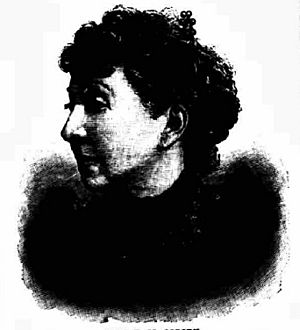Emily Mary Osborn facts for kids
Quick facts for kids
Emily Mary Osborn
|
|
|---|---|
 |
|
| Born | 11 February 1828 Kentish Town, London
|
| Died | 25 April 1925 (aged 97) St John's Wood, London
|
| Nationality | British |
|
Notable work
|
Nameless and Friendless (1857) |
| Spouse(s) | None |
Emily Mary Osborn (1828–1925), or Osborne, was an English painter of the Victorian era. She is known for her pictures of children and her genre paintings, especially on themes of women in distress.
Contents
Biography
Emily Osborn was born in Kentish Town in London, on 11 February 1828, the eldest of nine children of the Rev. Edward Osborn (1792–1859) and his wife Mary (née Bolland, 1806–1868). Osborn took up the curacy of West Tilbury under its rector Edward Linzee during the spring of 1834, when Emily was about five. The family occupied the parsonage at the top of Gun Hill, which is pictured in a lithograph of 1845 by D. Walton. Osborn lived for some eight years at the parsonage, though she afterwards recalled that her "early surroundings ... were not such as to develope artistic proclivities, there being but little natural beauty in the country around West Tilbury ...". There, her mother encouraged her "and watched with pride the clever portraits Emily drew of her brothers and sisters". The parent herself possessed a great love of painting and had, on her own account, "wished in vain to study Art professionally". The same article speaks of experimentation at this period, how the teenage girl, not always being able to obtain the paints she desired "devised a plan of making an extra supply of colours from flowers, by putting the petals into bottles with a little spirits of wine".
Her father's final entry in the parish registers of St. James', was on 2 November 1842, after which the family removed to London – "to the great delight of his eldest girl, who rightly considered there was now some chance of realising the hopes she entertained of one day becoming an artist". Thereafter she attended evening classes at the Dickenson academy in Maddox Street, where she was taught by John Mogford. After a period of three months, her father wanted her to stop lessons, presumably for financial reasons, but one of the masters, J.M. Leigh offered to teach her privately with another student. And so, she then studied privately under J.M. Leigh from Maddox Street, and later at his academy in Newman Street for a year. In 1851, at the age of seventeen, Osborn began showing her work in the annual Royal Academy exhibition, and continued to do so over a span of four decades until 1893.
In 1868, Osborn lost her mother "and for two years did no work of importance", then for six months she and her sister devoted themselves to nursing the sick and wounded in the Franco-Prussian War. "Then came her visits to Venice and Algeria, made familiar (to gallery-goers) by her pictures in the Grosvenor and elsewhere". At home, she also toured and painted among the Norfolk Broads.
Osborn never married and died aged 97 on 14 April 1925 in the home she had shared for many years with Mary Elizabeth Dunn, 10A Cunningham Place, St John's Wood, London.
Themes
Like other female artists of her time, she focused on literary works for inspiration as it was common for literary paintings to be vehicles female artists used to display their skill and obtain other work such as portraits and landscapes. However, distinguishing her from other female artists who created literary paintings, Osborn's typically were more complex and featured multiple figures to display her ability. For a period of time, her works also focused on the contrast between youth and age, like in Tough and Tender (1862) and Sunday Morning, Betzingen, Wurtemburg (1863). However, her work that got the most acclaim was her work that seemed to have a moralizing aspect. Osborn specialized in emotive scenes and often her subjects were young women and children. Her work was seen to have a moral or educational aspect and had a sense of truth and representation of the real world and subjects they depicted. For example, The Governess (1860), For the Last Time (1864), and Half The World Knows Not How the Other Half Lives (1864) were all three seen as conveying valuable moral lessons.
There was also a body of literature and painting focused on middle-class women who had to earn money. These works were often inspired by the middle-class women who wrote and painted these subjects and Osborn's Nameless and Friendless (1857) also plays upon this theme.
Nameless and Friendless
Osborn's most famous work is Nameless and Friendless (1857), which has been called "The most ingenious of all Victorian widow pictures." It depicts a recently bereaved woman attempting to make a living as an artist by offering a picture to a dealer, while two "swells" at the left ogle her. The creation of this piece was a product of its time. In the 1850s there was an influx of middle-class women into the urban environment of London. Women began more freely to occupy the streets and travel the city. They would walk the streets, take public transportation, etc. This opened up opportunities for women but also introduced new social dynamics and there were many debates about this new dynamic and way of urban life. Nameless and Friendless is one of the few publicly exhibited paintings by a woman to address these new urban dynamics during the 1850s.
Gallery







